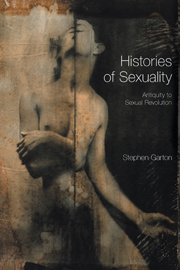Book contents
- Frontmatter
- Dedication
- Contents
- Preface
- 1 Writing Sexual History
- 2 Rule of the Phallus
- 3 Sexual Austerity
- 4 Christian Friendships
- 5 Making Heterosexuality
- 6 Victorianism
- 7 Dominance and Desire
- 8 Feminism and Friendship
- 9 Imagining Perversion
- 10 Normalizing Sexuality
- 11 Sexual Revolution
- Epilogue
- Endnotes
- Select Bibliography
- Index
11 - Sexual Revolution
- Frontmatter
- Dedication
- Contents
- Preface
- 1 Writing Sexual History
- 2 Rule of the Phallus
- 3 Sexual Austerity
- 4 Christian Friendships
- 5 Making Heterosexuality
- 6 Victorianism
- 7 Dominance and Desire
- 8 Feminism and Friendship
- 9 Imagining Perversion
- 10 Normalizing Sexuality
- 11 Sexual Revolution
- Epilogue
- Endnotes
- Select Bibliography
- Index
Summary
In 1962 journalist Helen Gurley Brown advised ‘nice single girls’ to say yes to sex. Men, she declared, were ‘a lot more fun by the dozen’. Similarly Hugh Hefner, publisher of Playboy, attacked the ‘ferocious antisexuality’ and ‘dark antieroticism’ in America, trumpeting the ‘end of Puritanism’. One of the most popular cultural narratives of the late-twentieth century has been the 1960s and 1970s as an age of ‘sexual revolution’. In the 1960s sexual liberalism may have became a very public discourse, but as historians such as David Allyn have argued the nature and forms of this revolution were contested.
For Brown, Hefner and others, the ‘sexual revolution’ became an advertising slogan and a source of great profit. Their magazines, journals, clubs and advice manuals sold in the millions to avid consumers of a fantasy of guilt-free sex, now possible with the invention of ‘the pill’. Hippies, however, challenged the conventional gender stereotypes implicit in the libertinism of Brown and Hefner. They promoted a new androgynous, pansexual ‘turn-on, tune-in, drop-out’ ethic. Other counter-culture groups, such as the ‘underground’ and the ‘yippies’, were more conventionally political, tying sexual revolution to a larger campaign of social revolt. For them, sexual libertinism was just one part of a wider protest against racism, middle-class respectability, the Vietnam War, colonialism, class oppression and educational conservatism. Graffiti and slogans, such as ‘make love not war’ or ‘the more I revolt the more I make love’, became forthright declarations of a new link between sex and politics.
- Type
- Chapter
- Information
- Histories of SexualityAntiquity to Sexual Revolution, pp. 210 - 228Publisher: Acumen PublishingPrint publication year: 2004



